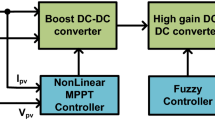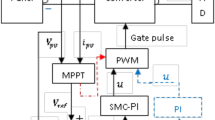Abstract
A time-domain design methodology for voltage regulation control of dc–dc boost and buck-boost converters based on a multi-loop controller with PI regulator for the outer loop and an inner loop with sliding mode current controller has been developed for renewable energy applications such as photovoltaic (PV)-fed dc–dc converters. This paper proposes a new method for the design of PI regulators in such multi-loop control scheme. The proposed design presents a simple analytical method for selecting controller gains and has been validated by simulation as well as hardware implementation. Also, this paper presents an illustrative example based on the proposed design for the voltage regulation control of PV-fed boost converters for off-grid applications. The simulation results for varying irradiation, temperature and load along with stability analysis have been presented in this paper. The proposed controller is implemented in hardware for a 1.1 kW PV-array-fed boost converter. Performance analysis based on field test results using real-time weather data validates the proposed design. Therefore the proposed controller could be considered as an attractive solution for off-grid renewable energy applications like PV- or fuel-cell-fed dc–dc converter, where the variations are stochastic in nature.

















Similar content being viewed by others
References
Matsuo H, Wenzhong L, Kurokawa F, Shigemizu T and Watanabe N 2004 Characteristics of the multiple-input DC–DC converter. IEEE Trans. Ind. Electron. 51: 625–631
Todorovic M H, Palma L and Enjeti P N 2008 Design of a wide input range dc–dc converter with a robust power control scheme suitable for fuel-cell power converters. IEEE Trans. Ind. Electron. 55: 1247– 1255
Cuk S and Middlebrook D R 1983 Advances in switched-mode power conversion part I. IEEE Trans. Ind. Electron. 30: 10–19
Cuk S and Middlebrook D R 1983 Advances in switched-mode power conversion part II. IEEE Trans. Ind. Electron. 30: 19–29
Davoudi A, Jatskevich J and De Rybel T 2006 Numerical state space average value modeling of PWM DC–DC converters operating in DCM and CCM. IEEE Trans. Power Electron. 21: 1003–1012
Sira-Ramirez H, Perez-Moreno R A, Ortega R and Garcia-Esteban M 1997 Passivity based controllers for the stabilization of DC–DC power converters. Automatica 33: 499–513
Sun J, Mitchell D M, Greuel M F, Krein P T and Bass R M 2001 Averaged modeling of PWM converters operating in discontinuous conduction mode. IEEE Trans. Ind. Electron. 16: 482–492
Aldo B, Corsanini D, Landi A and Sani L 2006 Circle based criteria for performance evaluation of controlled DC–DC switching converters. IEEE Trans. Ind. Electron. 53: 1862–1869
Cominos P and Munro N 2002 PID controllers: recent tuning methods and design to specification. IEE Power Contr. Theor. Appl. 149: 46–53
Escobar G, Ortega R, Sira Ramirez H, Vilain J P and Zein I 1999 An experimental comparison of several nonlinear controllers for power converters. IEEE Contr. Syst. Mag. 19: 66–82
He Y and Luo F L 2006 Sliding mode control of DC–DC converters with constant switching frequency. IEE Power Contr. Theor. Appl. 153: 37–45
Hung J Y Gao W and Hung J C 1993 Variable structure control: a survey. IEEE Trans. Ind. Electron. 40: 2–22
Tan S C, Lai Y M, Tse C K, Salamero L M and Wu C K 2007 A fast response sliding mode controller for boost-type converters with a wide range of operating conditions. IEEE Trans. Ind. Electron. 54: 3276–3286
Cheng K H, Hsu C F, Lin C M, Lee T T and Li C 2007 Fuzzy neural sliding mode control for DC–DC converters using asymmetric Gaussian membership functions. IEEE Trans. Ind. Electron. 54: 1528–1536
Gupta T, Boudreaux R R, Nelms R M and Hung J Y 1997 Implementation of a fuzzy controller for DC–DC converters using an inexpensive 8-b microcontroller. IEEE Trans. Ind. Electron. 44: 661–668
Perry A G, Feng G, Liu Y F and Sen P C 2007 A design method for PI like fuzzy logic controllers for DC–DC converter. IEEE Trans. Ind. Electron. 54: 2688–2696
Luo F L, Ye H and Muhammad H R 2005 Digital power electronics and applications. Elsevier Academic Press, San Diego, CA
Luo F L and Ye H 2007 Small signal analysis of energy factor and mathematical modelling for power DC–DC converters. IEEE Trans. Power Electron. 22: 69–79
Cervantes I, Garcia D and Noriega D 2004 Linear multiloop control of quasi-resonant converters. IEEE Trans. Power Electron. 18: 1194–1201
Sira-Ramirez H 1987 Sliding motions in bilinear switched networks. IEEE Trans. Circuits Syst. 34: 919–933
Acknowledgements
The authors acknowledges the All India Council of Technical Education (AICTE), Ministry of Human Resource and Development, Government of India, for award of National Doctoral Fellowship to the first author of this article, for pursuing his Ph.D, under which the present research work is carried out.
Author information
Authors and Affiliations
Corresponding author
Rights and permissions
About this article
Cite this article
PRAKASH, L., SUNDARAM, A.M. & JESUDAIYAN, S. A simplified time-domain design and implementation of cascaded PI-sliding mode controller for dc–dc converters used in off-grid photovoltaic applications with field test results. Sādhanā 42, 687–699 (2017). https://doi.org/10.1007/s12046-017-0631-y
Received:
Revised:
Accepted:
Published:
Issue Date:
DOI: https://doi.org/10.1007/s12046-017-0631-y




